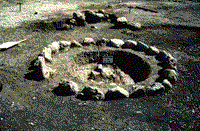The Necropolis of Campovalano
Since the 70's, excavations have been conducted within the large area of the proto-historical necropolis situated on a river terrace.
It includes over 600 tombs and burials dating from a period ranging from the late Bronze age to the Roman conquest (though the conducted research leads to believe that the necropolis conserves at least 20 thousand tombs in its subsoil).
The burials dating from the Bronze Age and the early Iron Age include very simple grave goods mainly made up of one bronze artefacts laid on the chest.
On the other hand, in the burials dating from the 7th and the 6th centuries B.C, it is possible to observe a change in the organisation of the burial itself ; changes which reflect the social inequalities of the period (as a matter of fact the stratification in social classes became apparent at that time). The tomb n.100 represents a particularly good example of this as its dimensions ( 4,70 m. long, 1,80 m. deep and 2,8 m. wide) and its grave goods seem to include all the symbols indicating a high social status. In fact the deceased seems to have been of a high military rank as the battle cart buried beside him testifies.
The offerings included in the burials dating from this period of “regia” have various importance and round barrows start spreading (tombs made of a 4 to 25 metres wide mounds of earth surrounded by a kerb).
Within the necropolis of Campovalano these types of tombs are divided into two big groups (west and east) each divided into further single subgroups. Such a disposition in groups typically reflects a social structure organised according to family groups (noble families) and favouritism.
Handmade bronze or ceramic services are present in both men and women's burials and attest the importance of the ideology of the banquet also underlined by the presence of groups of iron spits. Weapons are characterisic of men burials while instruments linked to sewing, weaving and spinning (needles, reels, spindles and whorls) characterise the womens' burials.
During the first millennium, the organisation of the necropolis undergoes a radical transformation. It evolves from the “monarchic” period to the first republican phase (half of the 5th to half of the 4th century B.C.) characterised by burials without grave goods and to the Hellenistic phase characterised by graves dug in the ground and oriented towards south (unlike previous tombs oriented towards west). The grave goods include turned ceramic vases often black-glazed. Numerous objects for body care can be found in the womens' burials such as instruments for ear and nail care, while curry combs, vases to carry sand and instruments linked to an “athletic representation of men” tend to replace weapons in the mens' burials.
The necropolis was used until the early 2nd century B.C., when the plain started being exploited for agricultural purposes again.
The rests of the necropolis are conserved inside the Museo Archeologico Nazionale di Campli.
Information taken from the Rete della Cultura Abruzzese (Sezione Siti Archeologici)

















